 |
Điện Hải Citadel
Da Nang, Vietnam
|
|
 |
Constructed: 1835-1847
Used by: Vietnam, France
Conflict in which it participated:
1858-1860 Fight
|
Our story begins at a similar point in history as does many an eastern starfort tale: With the arrival of the Portuguese. They "discovered" Vietnam in the early 16th century, and by the 1530's had begun trying to land there, to make friends and influence people in their usual manner.
But the Portuguese found that they couldn't land and start doing their thing, because of all of the violence that was occurring there on a regular basis, even without the assistance of the Portuguese! Huh, huffed the Portuguese, we're the ones who are supposed to cause discontent in far eastern places! |
 |
|
|
But the Vietnamese needed absolutely no outside help to achieve violent discontent. They had been fighting the Chinese and the Mongols for centuries, but by the time the Portuguese showed up were primarily fighting amongst themselves. Portugal, France, Holland and England were all interested in securing trade agreements with the Vietnamese in the early 17th century, but the Vietnamese were otherwise occupado.
Fortunately, the Vietnamese stopped fighting each other for just long enough to recognize the many benefits of trade with the western world, and eventually allowed French and Portuguese ships to land, under extremely controlled circumstances. This concession was made in the interest of trade, but the Vietnamese were rewarded with...missionaries. One of the tenets of Catholicism, at least at the time in question, was if there were some people who were not Catholics, they needed to be Catholics, and this seemed to be particularly true of persons with skin of a darker hue.
|
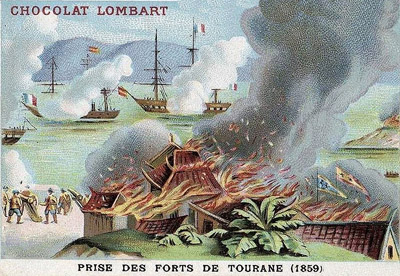 A depiction of the French "taking the forts of Tourane" (the French called Da Nang Tourane) in 1859, from the packaging of chocolate produced by the French Lombart company in the late 19th century. Should one wish for a more balanced representation of the battle, one might seek out wrappers from period Vietnamese chocolate. A depiction of the French "taking the forts of Tourane" (the French called Da Nang Tourane) in 1859, from the packaging of chocolate produced by the French Lombart company in the late 19th century. Should one wish for a more balanced representation of the battle, one might seek out wrappers from period Vietnamese chocolate. |
 |
And while there were surely plenty of missionaries with the purest of intentions, the relentless feeding of them into foreign societies that did not want them seems like nothing more than a way to claim a need for military action when those missionaries weren't treated with the respect to which their home governments felt they were due. Frequently this lack of respect took the form of imprisonment and/or execution, and punitive expeditions against the heathen Vietnamese followed.
In 1813, Vietnam's Nguyen Dynasty's first Emperor Gia Long (1762-1820) ordered that the mouth of the Han River at the important seaport of Da Nang be fortified. Some manner of fortification was duly constructed on both banks of the river: We can rest assured that these were no starforts, but they were named Dien Hai Fortress and An Hai Fortress. |
|
The next emperor, Minh Mang (1791-1841), directed that Dien Hai Fortress be moved slightly inland on a rise (clever emperor!) in 1823. Mang was no fan of the French, who were making increasing inroads into Vietnamese society, but he was apparently a fan of their style of fortification! When the moved 'n' improved fortress was completed in 1835, Vietnam had itself a classic four-bastioned starfort, of which Vauban would have been reasonably proud (although the Father of the Starfort surely would have had some improvements in mind). An Hai Fortress was upgraded to starfort status as well, assumedly during the same period.
Which begs the question: How does an insular, eastern dynasty build a proper starfort? The French would have been the ones to ask for starfort pointers, but the French were the enemy...and surely no member of the Nguyen Dynasty was touring western Europe, checking out their starforts? The information as to how this all came to pass seems to be missing from the sources I can find. Perhaps the Starfort Fairy fluttered down and waved her magic wand o'er the banks of the Han.
|
And by any standard, this was a substantial starfort: Around a third of a mile in diameter, with 16'-high brick walls and a 10'-deep ditch all around those walls. 'Tis reported that 30 "large artillery cannons" were mounted therein, and while "large" may have been a relative term, Dien Hai Citadel, as it was renamed once it was complete, was a spiny beast indeed for attacking navies to navigate past.
Plenty of aggressive naval navigation did indeed occur. Infuriated by the continued maltreatment of missionaries, the French and Spanish, the latter of whom had no reason to get involved other than a gleeful willingness to punish those who were rude to Roman Catholicism, sent punitive missions to the coast of Vietnam (and Vietnam is pretty much all coast) in 1847, and again in 1858.
The French mission in 1858 took a more sinister spin, however. Emperor Napoleon III (1808-1873) was pretty desperate to reestablish the impressive accomplishments of his uncle Nappy I (1769-1821), and needed some fresh overseas lands to be part of his empire. Pickings were already getting slim in the mid-19th century, what with the British, Portuguese, Spanish and Dutch already having been involved in the empire business for some 200 years...and French empirical ambitions had been interrupted by everyone ganging up on N3's poor uncle.
|
 |
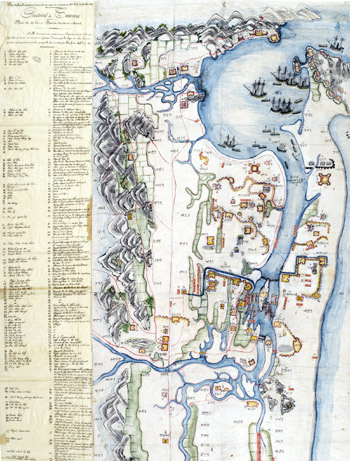 Positions de Tourane: All of Da Nang's fortified positions in 1859. Found in a Vietnamese mandarin's home, this map was likely a Godsend for the French, who added the numerous annotations on the left. Dien Hai Citadel is just to the left of the mouth of the Han River, and An Hai Fortress is on the right side, looking to be the larger of the two in this illustration at least. Sadly, An Hai ain't no more. Positions de Tourane: All of Da Nang's fortified positions in 1859. Found in a Vietnamese mandarin's home, this map was likely a Godsend for the French, who added the numerous annotations on the left. Dien Hai Citadel is just to the left of the mouth of the Han River, and An Hai Fortress is on the right side, looking to be the larger of the two in this illustration at least. Sadly, An Hai ain't no more. |
|
And, the Nguyen Dynasty did what France was probably hoping it would do: In 1858, feeling threatened by the influence of foreign religion, Emperor Tu Duc (1829-1883) ordered the execution of two Spanish missionaries. Chortling with glee, Napoleon III sent a force of fourteen gunships, ferrying a few thousand French and Filipino troops (the latter of whom had been thoughtfully provided by Spain) to smite Vietnam a mighty, punitive blow...but that blow became an invasion.
|
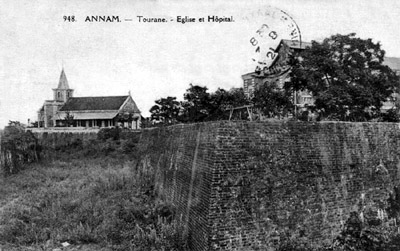 A postcard from sometime when there were both photography and postcards: Tourane - Church and Hospital. The French curled their collective lip at the though of using this faux starfort for actual defensive purposes, so they used it for other things. A postcard from sometime when there were both photography and postcards: Tourane - Church and Hospital. The French curled their collective lip at the though of using this faux starfort for actual defensive purposes, so they used it for other things. |
 |
Added to the intolerable outrage of the executed missionaries was the fact that Hong Kong had, in 1842, solidly become part of the British Empire...and the French wouldn't have been the French if they allowed that to pass without striving to one-up, or at least match it. On September 1, 1858, the starfort of our current interest played a role in this unfolding drama when the French fleet opened fire on Da Nang.
The eastern bank of the Han, including An Hai Citadel, swiftly succumbed to the bombardment and a following landing by French and Spanish troops. The heroic Dien Hai Citadel, under the command of equally heroic General Nguyen Tri Phuong (1806-1873), held out for exactly one more day. |
|
One more day. While this doesn't seem to have been much of an accomplishment in the grand scheme of things, keep in mind that this was the start of nearly a century of French domination of Vietnam, and any demonstrable victory over the French, no matter how small, was worthy of celebration: Dien Hai Citadel's garrison fought off "dozens of French attacks at the mouth of the Han River." And while General Nguyen Tri Phuong lost the citadel, he carried on a guerilla campaign against the French in and around Da Nang, which led to this particular campaign's failure: The French pulled out in March of 1860, but returned two years later and captured Saigon...and by the 1880's occupied all of Vietnam.
|
Da Nang officially (to the French at least) became Tourane in 1888. Dien Hai Citadel, which had been repaired after the French left in 1860, was determined to be "too small" to do the things a starfort is designed to do, so its new owners built a military hospital within its walls: This operated as Tourane's main hospital for a period, until a bigger one was constructed elsewhere in the city. In 1900, Da Nang's first Roman Catholic church was built in our Citadel.
France's occupation of Vietnam was never an easy one. Most Vietnamese seemed stubbornly disinterested in being ruled by France, even after the many reasons ocupation was so awesome had been patiently explained to them.
|
 |
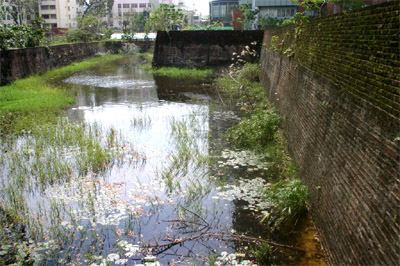 Dien Hai Citadel's exterior, with a weed-choked moat that looks a lot like the weed-choked moats of several American starforts I've visited! Dien Hai Citadel's exterior, with a weed-choked moat that looks a lot like the weed-choked moats of several American starforts I've visited! |
|
During this period of occupation, the Vietnamese revolted on several occasions. France also cast covetous eyes on Siam, which today is Thailand, manufacturing incidents to use as excuses for further armed conquest. Fortunately for Vietnam, France was occupied with being occupied itself during the Second World War (1939-1945). In 1940 France's Vichy government granted Japan access to Tonkin, the northernmost portion of Indochina, because Germany politely asked it to do so.
In the last months of the war, Japan took complete control of the region, destroyed the French colonial administratioin and declared Vietnam, Cambodia and Laos to be independent nations and members of the Greater East Asia Co-Prosperity Sphere...which sounded nice, as this Sphere's stated intent was to protect Asian folks from western colonialism, but in reality just served as a means by which Japan could dominate lots and lots of places and people, and the Japanese weren't any nicer as imperial masters than the westerners had been. Folks who fell under this "sphere" were surely overjoyed, until they noticed that the Japanese were killing them.
|
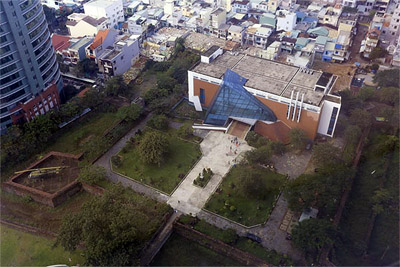 Dien Hai Citadel's interior is today dominated by the Da Nang Museum. This is at least partially a military museum, with what sounds like one of the finest collections of 1970's American military hardware this side of Aberdeen Proving Grounds in Maryland! Dien Hai Citadel's interior is today dominated by the Da Nang Museum. This is at least partially a military museum, with what sounds like one of the finest collections of 1970's American military hardware this side of Aberdeen Proving Grounds in Maryland! |
 |
Following that war, the victorious powers had no idea what they wanted to do with Vietnam, but they were in semi-unanimous agreement that France should not attempt to resume its colonial role there. France didn't receive (or chose to ignore) this memo, however, and the ensuing struggle solidified the position of Ho Chi Minh (1890-1969), who had founded and led the Viet Minh, a nationalist, anti-imperial and Communist movement against the Japanese during the Second World War. Uncle Ho's efforts assisted the French in losing their hold on Vietnam after the Battle of Dien Bien Phu in 1954, and he and his plucky people went on to defeat the well-intentioned yet tragically fumblefooted United States in the Vietnam War (1955-1975). |
|
During that conflict, Da Nang served as one of American's main airbases in-country: At the end of the 1960's, it was the busiest airport in the world. If any of the many American servicemen who spent time in Da Nang had opinions about Dien Hai Citadel, those opinions apparently went unrecorded...although our fort was likely a completely overgrown shrubbery at the time.
|
In which state it remained until the 1980's, when efforts to reclaim it from nature began. Plonked onto Dien Hai Citadel's parade ground, the Da Nang Museum was opened in 2005, but the lengthy process of its construction revealed a few cannon that had been used to briefly deflect the French in 1858, buried within the fort's walls.
Today the slightly exteriorally hideous Da Nang Museum, guarded by a statue of hero of the 1858-1860 Fight Nguyen Tri Phuong, is open every day for the low low admission price of $1. In addition to captured American and French military hardware, this three-story museum boasts a vast collection of really quite lovely ancient Vietnamese carvings, and various other regional cultural artifacts.
|
 |
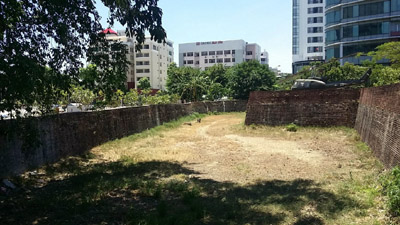 Dien Hai Citadel's southeast bastion, which may be the world's only starfort bastion with a US Army Bell UH-1 Iroquois helicopter displayed en barbette! This helicopter was "seized" at Da Nang Airport in 1975. Dien Hai Citadel's southeast bastion, which may be the world's only starfort bastion with a US Army Bell UH-1 Iroquois helicopter displayed en barbette! This helicopter was "seized" at Da Nang Airport in 1975. |
|
Endless thanks to alert starfort fan Marco Bos, who visited the Da Nang Museum in 2019, noted that it was in a starfort, and dropped me a line to let me know about it! The internet's starfort knowledge is indebted to you, Marco!
|
|
|
|
|
|
 |




